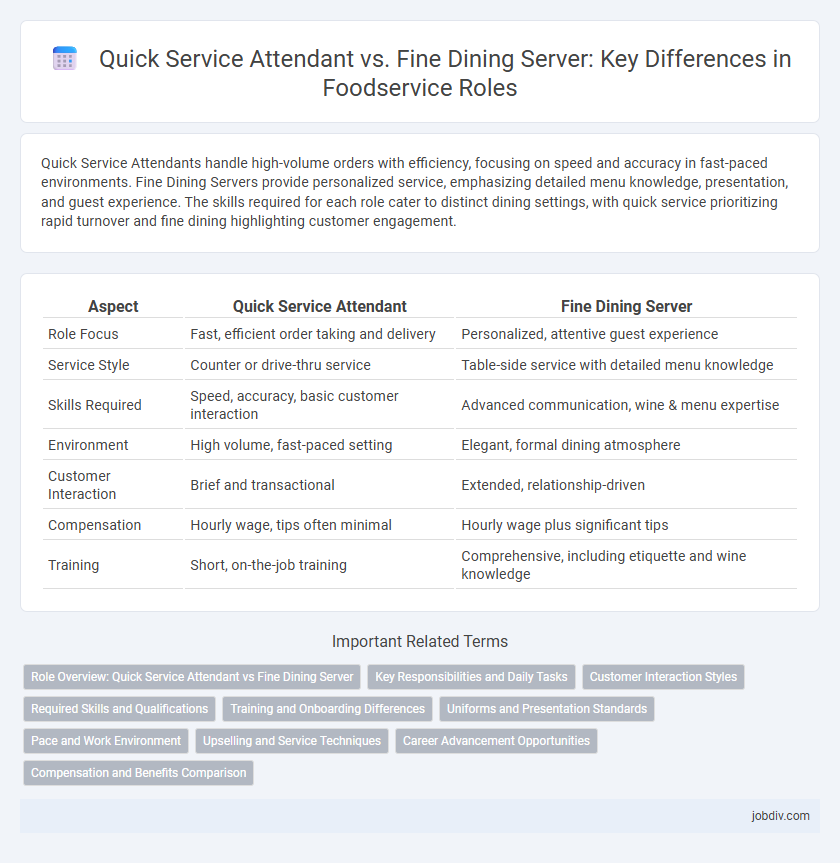Quick Service Attendants handle high-volume orders with efficiency, focusing on speed and accuracy in fast-paced environments. Fine Dining Servers provide personalized service, emphasizing detailed menu knowledge, presentation, and guest experience. The skills required for each role cater to distinct dining settings, with quick service prioritizing rapid turnover and fine dining highlighting customer engagement.
Table of Comparison
| Aspect | Quick Service Attendant | Fine Dining Server |
|---|---|---|
| Role Focus | Fast, efficient order taking and delivery | Personalized, attentive guest experience |
| Service Style | Counter or drive-thru service | Table-side service with detailed menu knowledge |
| Skills Required | Speed, accuracy, basic customer interaction | Advanced communication, wine & menu expertise |
| Environment | High volume, fast-paced setting | Elegant, formal dining atmosphere |
| Customer Interaction | Brief and transactional | Extended, relationship-driven |
| Compensation | Hourly wage, tips often minimal | Hourly wage plus significant tips |
| Training | Short, on-the-job training | Comprehensive, including etiquette and wine knowledge |
Role Overview: Quick Service Attendant vs Fine Dining Server
Quick Service Attendants handle fast-paced customer interactions, focusing on order accuracy, speed, and efficient food delivery in casual dining environments. Fine Dining Servers provide personalized service, detailed menu knowledge, and meticulous attention to guest preferences in upscale restaurants. Both roles demand strong communication skills, but fine dining emphasizes a refined service experience and extensive etiquette.
Key Responsibilities and Daily Tasks
Quick Service Attendants prioritize speed and efficiency by taking orders, handling cash transactions, and assembling food items quickly to serve customers in fast-paced environments. Fine Dining Servers focus on providing personalized service, including presenting menus, recommending wine pairings, and ensuring a sophisticated dining experience through attention to detail and timing. Both roles require strong communication and customer service skills but differ significantly in interaction depth and service complexity.
Customer Interaction Styles
Quick Service Attendants prioritize efficiency and speed, engaging customers with brief, direct communication to ensure fast order taking and delivery. Fine Dining Servers emphasize personalized, attentive interaction, using detailed menu knowledge and refined etiquette to create a memorable dining experience. The contrast in customer interaction styles reflects the differing service expectations and operational pace within foodservice environments.
Required Skills and Qualifications
Quick Service Attendants require strong multitasking abilities, fast communication skills, and basic food handling certifications to efficiently manage high-volume orders and customer interactions. Fine Dining Servers need advanced knowledge of culinary terms, wine pairings, and exceptional interpersonal skills to provide personalized service in a refined atmosphere. Both roles demand excellent customer service, but Fine Dining Servers often require formal training or experience in upscale hospitality settings.
Training and Onboarding Differences
Quick Service Attendants undergo streamlined training emphasizing speed, basic customer service, and order accuracy to efficiently handle high-volume, fast-paced environments. Fine Dining Servers receive extensive onboarding covering menu knowledge, wine pairing, etiquette, and personalized guest interaction, fostering an elevated dining experience. Training duration for fine dining roles is significantly longer, reflecting the complexity and refinement of service standards compared to quick service settings.
Uniforms and Presentation Standards
Quick Service Attendants typically wear practical, branded uniforms designed for efficiency and ease of movement, often including polo shirts, aprons, and hats that emphasize cleanliness and quick identification. Fine Dining Servers adhere to strict presentation standards, donning formal attire such as tailored suits, crisp white shirts, and polished shoes to enhance the upscale dining experience. Uniforms in fine dining settings must maintain immaculate grooming and often include accessories like bow ties or vests to reflect sophistication and professionalism.
Pace and Work Environment
Quick Service Attendants operate in fast-paced environments prioritizing speed and efficiency to handle high customer turnover, often managing multiple orders simultaneously with minimal interaction. Fine Dining Servers work in slower-paced, elegant settings that emphasize personalized service, attention to detail, and building rapport with guests to enhance the dining experience. The contrasting work environments dictate distinct skill sets: quick adaptability and rapid multitasking for Quick Service Attendants versus refined communication and meticulous presentation for Fine Dining Servers.
Upselling and Service Techniques
Quick Service Attendants focus on speed and efficiency, using suggestive selling techniques to quickly upsell menu items and promote combos, optimizing average ticket size. Fine Dining Servers employ personalized service with detailed menu knowledge, creating a tailored experience that encourages guests to explore premium dishes and wine pairings, significantly increasing revenue per table. Both roles rely on effective communication, but fine dining emphasizes relationship building while quick service prioritizes fast, impactful interactions.
Career Advancement Opportunities
Quick Service Attendants often experience faster career advancement through roles like shift supervisor or restaurant manager due to high turnover and standardized training programs. Fine Dining Servers gain advancement by honing specialized skills such as wine knowledge and personalized service, leading to positions like sommelier or maitre d'. Career progression in fine dining typically requires more experience and formal training but offers greater potential for reputation building and management roles.
Compensation and Benefits Comparison
Quick Service Attendants typically earn lower hourly wages, around $10-$15, with limited benefits such as basic health insurance and minimal tips. Fine Dining Servers receive higher compensation, often $15-$30 per hour including tips, alongside comprehensive benefits like health coverage, paid time off, and employee discounts. The fine dining sector offers greater earning potential and more robust benefits packages compared to quick service roles.
Quick Service Attendant vs Fine Dining Server Infographic

 jobdiv.com
jobdiv.com